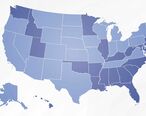8 Elements of an Age-Friendly Community
Age-friendly communities - cities, towns, villages and even counties and states - are great places to grow up and to grow old. An age-friendly community, no matter its size, supports people to be active, healthy, productive and socially included throughout their lives.

Age-friendly communities - cities, towns, villages, and even counties and states - are great places to grow up and grow old. An age-friendly community, no matter its size, supports people to be active, healthy, productive, and socially included throughout their lives.
The World Health Organization (WHO) has identified 8 key factors that influence the health and well-being of older adults, and that can help residents and community leaders develop a common vision for building communities that are great places to grow older:
- Transportation: Being able to get where you need to go is essential. Age-friendly communities prioritize safe, reliable, and easy-to-use travel options like affordable public transit, rideshare options, and safe walking and biking opportunities;
- Housing: Many older adults want to stay in their own homes or communities for as long as possible. Age-friendly communities support diverse housing options that allow older adults of all incomes to live in clean, safe, comfortable, and well-maintained housing and encourage the availability of a strong network of home-based services to meet resident needs.
- Outdoor Spaces and Buildings: Public places where residents can gather make life more appealing for residents of all ages. Age-friendly communities support green spaces (like parks), safe streets, sidewalks, and accessible buildings that can be used and enjoyed by people of all ages and abilities.
- Social Participation: Social participation and physical activity are essential for quality of life and longevity. Age-friendly communities support engagement through life-long learning, social, cultural, and other types of activities for older adults.
- Respect and Social Inclusion: Everyone wants to feel valued. Age-friendly communities celebrate and tap into the wisdom and experience of older adults, encourage multicultural understanding, and often work collaboratively to eliminate ageism.
- Civic Participation and Employment: Whether working for pay or volunteering, many older adults value contributing to their communities. Age-friendly communities support services for mature jobseekers who need or want to work and encourage older adults to share their skills to address community needs.
- Community and Health Services: All people should have access to affordable age-friendly health care and community services that help them live comfortably and with dignity. Age-Friendly communities support the coordination and promotion of age-friendly health care that meets the needs and wants of older adults and caregivers.
- Communication and Information: Older adults receive information in a variety of ways, and no one way reaches every person. Age-friendly communities promote communication and community partnerships that increase access to information that older adults need as they age.
Age-friendly cities and towns bring together a range of stakeholders within the community with different areas of expertise to develop guidelines and plans that improve life for older adults and often use the factors outlined above to guide their planning.
As you consider where you or someone you care about will grow older, it’s a good idea to explore how a city, town, or county addresses the elements most important to you. A great place to start is learning whether the community embraces age-friendly principles. You can start your search for an age-friendly community on AgeFriendly.org today.















There are no comments for this article yet. Be the first to leave a comment